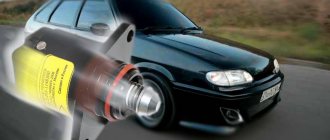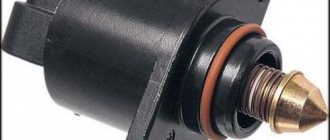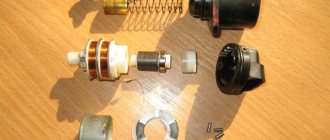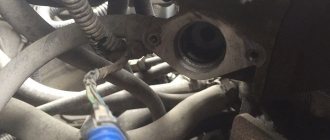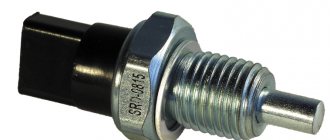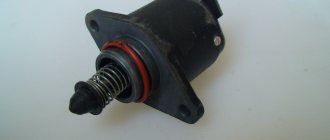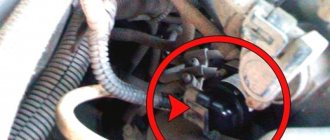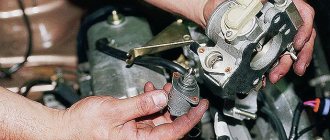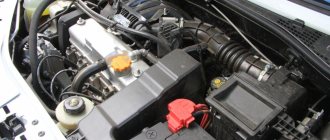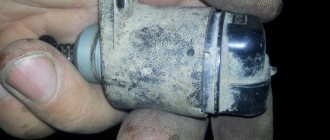1. Disconnect the wire from the “negative” terminal of the battery.
3. Having released the latch, disconnect the wiring harness block from the idle speed control.
4. Using a Torx T-20 wrench, unscrew the two self-tapping screws securing the IAC to the throttle assembly.
For clarity, we show the operation on the removed intake pipeline.
5. Remove the idle speed control.
Note:
Before installing the regulator, clean the valve seat, air channel and the surface under the regulator's sealing ring in the throttle assembly.
The IAC connection is sealed to the throttle assembly with a rubber ring
6. Apply engine oil to the new regulator o-ring.
7. Install the idle speed control in the reverse order.
Possible configurations of Lada Largus
The question of choosing an internal combustion engine arises only for owners of the base model of the car. The happy owners of the updated Lada Largus Cross are not puzzled by this choice, as are those who are willing to pay for the Luxury package of their iron horse, where everything is included (including the most powerful modification of the power unit). The following engine can be installed on the domestic version of Reno Logan MCV:
Of course, bare numbers won’t tell you anything about the advantages of a particular power unit for those who prefer to be scrupulous when buying a car. After all, in terms of comfort, handling and prestige, outwardly it remains the same car. Therefore, in order to find out what a particular engine is capable of, it is worth assessing the technical characteristics of the car.
Damage to throttle valve O-rings
2 o-rings are responsible for the tightness of the throttle valve connection. One of them is located on the intake manifold side, the second on the air filter side.
Over time, the rubber rings dry out. The material loses volume and shape. Because of this, the system becomes leaky and air begins to enter it.
Idle speed can only be affected by the seal located on the intake manifold side. If the ring has dried out and lost volume, the revolutions will float. The second seal does not affect idle speed, but it also needs to be checked.
You can make the system sealed again in different ways:
- Install new original seals.
- Install non-original rubber rings of suitable size.
- Wrap the throttle valve with fum tape and install the old seals.
We do not recommend installing non-original seals. Except when you are confident in the quality of the materials and the manufacturer.
Floating idle speed can be explained by other reasons. Therefore, it is better to entrust the repair to a specialist. He will check the condition of the car and make sure there are no other faults.
Source
floating speed LARGUS 8 KL — DRIVE2
Happy upcoming holidays everyone! peace and goodness! A WEEK AGO THE TURNOVER STARTED TO FLOAT. the topic is already hackneyed and not interesting to anyone, and everything is clear here. So I turned on Google, came to the garage and began to fix the problem! I TOOK OFF the box with the filter, I still don’t understand why it’s so big, I disconnected the sensors from the throttle, the tubes and everything that was in the way, and somehow I touched this piece of pipe with the damper with my hand and it moved! Strange... I thought. I'm not a mechanic, so the general idea is that something is wrong. Should he walk like that? I shook it with my hand again and made sure that it was playing and not weakly! I direct my eyes more closely and see that my throttle is pressed on one side! but in front of one fastening there is just a hole and nothing holds it! it doesn’t press! It immediately became clear that something was wrong here... IN THE RESULT - the fastener that presses the throttle on one side is missing! And then it began... having ridden a couple of shops on a bike to nearby ones, the verdict was the same - out of stock! to order... well, the tail is with you! I thought and went to collective farm. I bent the piece of iron into shape so that it would serve as a clamp, found a self-tapping screw to match the diameter of the original, cut it to length, placed a nut and...started screwing...OH MY GOD! How I remembered Nicolas Sarkazy and all his stories PURELY in Russian! twist this crap... it was atas! the ramp was in the way, the sun was shining, you couldn’t reach with your fingers, your hands were worn out! I really have to suffer, I bent my mount a couple of times and finally screwed it up! …OH YES! Google was nearby and I had to watch this particular video where the guy wraps a foam sealer around the o-ring at the bottom of the throttle body where it is inserted into the manifold... damn...! if the elastic band loses its elasticity and I could see a trace that was sucking air in the place where there was no fastening. there was dust and the elastic band itself was a little deformed. then if you wrap it with fumlenta, it will completely lose its properties! my conclusion is that we need to put rubber bands on the seat of this seal! AGAIN remembering the people eating frogs and holding the Mistra for us - lei, redid everything, aaaand started it! AGAIN MY little bottle started up PLEASANTLY and purred... the arrow twitches a little but it was like that again or the filter it's time to change it and not how I blow it with a compressor! I changed the spark plugs, there was also a story there, but more on that later!
Why do the revs fluctuate on the Lada Largus?
According to reviews, the problem with floating engine speeds is familiar to many Lada Largus owners. This is especially true in winter, when the car has difficulty starting when cold (starting the engine is difficult in the morning). In such situations, floating speeds only make the situation worse. The tachometer needle may jump chaotically from 1000 to 1500 rpm or not reach the “warm-up” level at all, staying below the required idle speed values. Experts do not recommend self-diagnosis of the car. If the cause of the problem is unknown, it is better to contact a service station.
Car engine modifications and their features
The reasons why the speed may fluctuate on Largus are due to differences in the technical characteristics of the engines. Depending on the configuration, an 8- or 16-valve engine is installed.
8-valve K7M 800
This engine model was borrowed from Renault Logan and Sandero. Such motors have been installed on Largus since 2010. The unit complies with the Euro-4 standard, its power is 83 hp. With. Among the disadvantages:
floating idle speed;
high fuel consumption;
lack of hydraulic compensators in the valve mechanism - the gaps need to be adjusted every 30,000 km; the need to replace the timing belt every 60,000 km - a broken belt will inevitably lead to bending of the valves; unreliability of crankshaft oil seals; vibration and increased noise during operation of the power unit.
The 8-valve engine is too weak for Largus. Among the advantages are the unpretentiousness of the engine and its inexpensive maintenance.
replacement for pxx largus.
| Replacing the idle speed sensor on LADA Largus |
| Issue No. 4 is devoted to replacing the idle speed sensor on LADA Largus (2013, engine size 1.6). After looking... |
| Tags: |
| REMOVE ROD. Calibration of IAC on Renault Logan |
| Click to view | Full video on cleaning the throttle valve: . |
| Tags: |
| Replacing the idle air valve Renault Logan, Sandero, Largus |
| Click to view | Replacing the idle air valve Renault Logan, Sandero, Largus Eliminating floating idle speed... |
| Tags: |
| The revs of Lagrus, Duster, Logan, etc. are floating. Solution. Cleaning the throttle. |
| Group VK - ICE Megane 3... |
| Tags: |
| Elimination of floating idle speed on Renault Logan, Sandero, Largus, Duster |
Click to view
Attention !!! We have released an addition to this video, before performing the work, be sure to watch https://www.y...
Tags:
| Replacing the idle speed sensor, Renault. (Renault simbol) |
| We repair the Renault Symbol idle speed sensor, wash it and change the lubricant. |
| Tags: |
| IAC CLEANING. Regulator training. Cleaning the throttle. REFILL. | Video lecture #2 |
| Cleaning the IAC idle speed controller, also called the idle speed sensor, cleaning the throttle valve... |
| Tags: |
| Why do the revs float or freeze on Renault Logan, Lada Largus, Renault Sandero, Nissan Almera G15 |
|
| Lada Largus high idle speed |
| Click to view | This problem started with the onset of cold weather, the warm-up started at 2 thousand and then the engine went crazy... I guess... |
| Tags: |
| floating speed Renault Logan 16 cl. |
| We are repairing Largus. The problem is in the small idle speed, which is significantly lower than it should be, the car seems... |
| Tags: |
| RPM TOO LOW Lada Largus QUICK REPAIR |
| A very common problem among Largus owners. Rough idle is not always due to... |
| Tags: |
| Largus revs when cold |
| How to check the idle air control. Several ways. My LIVE channel... |
| Tags: |
| How to check the idle air control. Several ways. |
| Click to view | cleaning the idle speed sensor. |
| Tags: |
| how to clean the idle air control sensor |
| Looking for a job? There is an excellent vacancy in a large taxi company. Flexible schedule, quick processing, up to 80,000 rubles... |
| Tags: |
| Does the idle speed fluctuate? Useful tips |
| IAC problem due to rod wear. #RuslanK. |
| Tags: |
| Engine IAC. It stalls when you let off the gas and has trouble starting. |
| When idling when the car is warm, the idle speed freezes and does not drop to the required 800, but only... |
| Tags: |
| Lada Largus, Renault Logan, high speed |
| How to properly replace the IAC (idle air regulator). VAZ, Lada SAMARA, foreign cars. VK group: ... |
| Tags: |
| replacing idle air control |
| Issue No. 5 is devoted to replacing the throttle sensor on LADA Largus (2013, engine size 1.6). Look... |
| Tags: |
| Replacing the throttle sensor on LADA Largus |
| Problems with the ignition system. To avoid watching ads, install Adblock Plus. . |
| Tags: |
| Lada Largus. Problems with the ignition system. |
| tool set a... |
| Tags: |
| Cleaning the throttle valve and replacing DUSTER o-rings |
| Checking, replacing, adjusting and calibrating IAC. Evgeniy will show and tell you how to check, replace... |
| Tags: |
| Idle air control Renault Logan and Chery Amulet Which is better |
| Click to view | A description of the modification is on the drive. Here is the link: … |
| Tags: |
| Checking, replacing, adjusting and calibrating IAC" rel="spf-prefetch |
| Description missing |
| Tags: |
| Elimination of floating speeds on Largus" rel=»spf-prefetch |
Damage to throttle valve O-rings
2 o-rings are responsible for the tightness of the throttle valve connection. One of them is located on the intake manifold side, the second on the air filter side.
Over time, the rubber rings dry out. The material loses volume and shape. Because of this, the system becomes leaky and air begins to enter it.
Idle speed can only be affected by the seal located on the intake manifold side. If the ring has dried out and lost volume, the revolutions will float. The second seal does not affect idle speed, but it also needs to be checked.
You can make the system sealed again in different ways:
- Install new original seals.
- Install non-original rubber rings of suitable size.
- Wrap the throttle valve with fum tape and install the old seals.
We do not recommend installing non-original seals. Except when you are confident in the quality of the materials and the manufacturer.
Floating idle speed can be explained by other reasons. Therefore, it is better to entrust the repair to a specialist. He will check the condition of the car and make sure there are no other faults.
Calibrating pxx in several ways
After installing a new sensor, as we wrote above, the speed may fluctuate again. To do this you need to calibrate. You can do this in two ways:
- Using a professional dealer diagnostic scanner
- Independently using the calibration algorithm embedded in the ECU
The first method involves contacting an official dealer, but we will describe the second in detail below.
After replacing the pxx sensor, we put the negative terminal of the battery back on. The old sensor's calibration data has been reset. Now we proceed as follows:
- Turn on the ignition but do not start the engine for 5-10 seconds
- We start the engine (the speed may jump or be increased)
- We turn off the engine (at this moment the rod pxx occupies another extreme position)
- We carry out the procedure several times
- Next, start the engine and let it run for 3-5 minutes.
Calibration should be completed and the speed will “return” to normal
You can replace the pxx sensor and calibrate it yourself, without the help of specialists. We hope that our instructions will help you save money on car services.
Lada Largus 2013, engine Gasoline 1.6 liter., 105 hp, Front drive, Manual - DIY
Comments 26
Hello! I would like to ask if you have an electronic gas pedal?
cable car 2013.
The xx sensor can be cleaned every week, it will always be dirty...
Just cleaned it for the first time. The throttle valve was clean, oddly enough, much cleaner than after a run of about 10-15 thousand... now 32
The xx sensor can be cleaned every week, it will always be dirty...
I filmed it today. Just a little bit of dirt... I drove about 2-3 thousand...
You could not take it off, but clean it with a slipper... on the floor, it will wash itself 
so at the same time... At the same time I checked your statement...
1.) Disconnect the battery for 15-20 minutes (I disconnected it at night) 2.) Connect the battery. 3.) Turn on the ignition but do not start the engine, wait until the lights go out for another 10-15 seconds 4.) Turn off the ignition. 5.) Repeat points 3.) and 4.) three to five times. 6.) Turn on the ignition and start the engine.
I have known this algorithm since the time of 21114, although point 5.) was not in it. Just in case, I did it too. The algorithm reminded renby in the note Idle air control - IAC
By the way, this must be done if any sensor has been changed or touched/moved, unscrewed/tightened. The controller re-interrogates all sensors and remembers their zero values, i.e. retrained.
Today I finally did all the work on cleaning the XX sensor and cleaning the throttle body. I barely pushed this crap into the sensor... then I tried to do it according to the algorithm... still the speed is crazy. I removed the terminal and began to touch the battery with it until the sensor moved... then I started it... and everything became normal)
I surfed the Internet a little and added to the article Where is my engine assembled? OIL LEVEL IS NOT LOWER OR ABOVE THE REQUIRED LEVEL!
Excessive amount of oil in the engine leads to an increase in the amount of crankcase gases - this leads to coking of the throttle valve in the engine intake tract.
I have 5 mm below the upper limit of the ribbed surface of the probe.
this is just half a liter, I had this on both Largus from the factory
from the factory it was 5-7 mm above the upper limit) somewhere around 600-700ml... What is the correct level, there are several options. All because of these French... why can't we do min and max...
I read somewhere that our engines don’t like oil overflow, it was a long time ago, I don’t remember where, but in my opinion the source could be trusted, so I drained it right away
It’s clear that there must be the correct level, but how can we determine it on our dipstick? I believe that the ribbed surface is a level range. correct. Some people think that the line that is filled in at the factory is the correct level. It’s not for nothing that this line is there
I also believe that the ribbed surface is a level, the dashes are the imprint of the blank with which this ribbed surface is applied to the probe, i.e. weld, technological seam, etc. etc., in general they do not carry an information load
But there is a strange thing... everywhere they write that 4.7 or 4.8 (I don’t remember exactly) should fit into the engine, but for me it fit 4.3)))
Well, not everything is drained + the filter, on 2111 the norm was never filled either, no matter how hard I tried to drain it, there are apparently cavities where the oil remains
I read somewhere that our engines don’t like oil overflow, it was a long time ago, I don’t remember where, but in my opinion the source could be trusted, so I drained it right away
The car did not work for long after cleaning, it still works strangely. maybe that wasn't the reason. And it looks like some kind of video is making noise... although I could be wrong.
What is pxx, its functions and operating principle
Before we begin to describe the malfunctions and the process for eliminating them, it is worth saying a few words about the idle air regulator.
The pxx sensor is installed in the throttle body. With its help, the ECU (electronic engine control unit) regulates the engine's idle speed. The idle air valve regulates the crankshaft speed by metering air flow through a bypass channel parallel to the throttle valve.
When the engine is warmed up to operating temperature, the computer supports the operation of the sensor. If the engine is cold, the ECU uses pulses to control the operation of the sensor and increases the speed to warm up. Gradually the speed decreases as it warms up.
When and how to do it yourself
When to do it
adaptation of the throttle valve zero and adaptation of the misfire diagnostic function:
- After replacing the ECU controller or resetting the controller using a scan tool.
- After replacing the throttle assembly.
Throttle zero adaptation procedure
:
- When the car is stationary, you must turn on the ignition, wait 30 seconds, turn off the ignition, wait until the main relay turns off.
Adaptation will be interrupted
, If:
- the engine turns over;
- the car is moving;
- the accelerator pedal is pressed;
- engine temperature is below 5 °C or above 100 °C;
- Ambient temperature is below 5 °C.
Adaptation procedure
Misfire diagnostic functions:
- warm up the engine to operating temperature (parameter value “Coolant temperature” = 60.90 °C);
- accelerate the car in 2nd gear until higher crankshaft speeds are reached (parameter value “Engine crankshaft speed” = 4000 min-1) and perform engine braking (“Engine crankshaft speed” = 1000 min-1);
- Perform engine braking six times in one trip.
Symptoms of a faulty pxx sensor
If you notice one or more of the following symptoms, you will most likely need to replace the idle speed sensor.
- Unstable engine speed at idle
- engine stalls when shifting gears
- When the engine warms up, the speed does not increase
- reduction in engine speed under load (turning on headlights, heater, etc.)+
- Unstable engine speed at idle when the engine is warm
- Floating engine speed
It is also worth noting that when installing a new sensor, the speed may also “float”. The reason for this is the lack of calibration of the new sensor. Simply put, the computer does not see the new sensor, so it is necessary to carry out calibration, which we will write about below.
Causes and methods of eliminating difficult engine starting
To successfully start the engine, the fuel mixture and a spark from the spark plugs must simultaneously appear in its cylinders.
If floating idle speeds have become too annoying, and it is no longer useful to turn the engine with the starter, it’s time to understand the causes of the malfunctions that have arisen. The table shows the most common reasons why the Lada Largus engine speed fluctuates and it may not start.
| Cause | Diagnosis and manifestations |
Remedy
You should not randomly change all the parts without first checking their functionality. Comprehensive diagnostics are necessary, since there can be several sources of malfunction at once. Modern cars of the VAZ family are equipped with the same type of engines. For this reason, the solution to the problem will be virtually the same for different cars.
The fundamental difference between engines with 8 and 16 valves
AvtoVAZ began a good tradition of producing cars with internal combustion engines with different numbers of valves back from the “ten”, where it was possible to install a 16-valve head on the engine even independently, and Largus was no exception. The production technology of an 8-valve power unit is simpler and was developed by the Lada automaker back in the 80s. The production of an engine with 16 valves is considered more modern and complex, which is why the price is higher.
The simplest power unit of the Lada Largus, with a total of 8 valves, has only two valves per cylinder, this is easy to check thanks to simple mathematics. In this case, there is no separated intake and exhaust system and there is no effective gas exchange. This affects engine efficiency and fuel consumption.
Idle air regulator Lada Largus general description
The idle speed regulator of the Lada Largus maintains a given engine idle speed with the throttle valve fully closed during its start-up, warming up and when the load changes when auxiliary equipment is turned on. The regulator changes the amount of additional air supplied to the intake system in addition to the throttle body, and is an electromechanical valve attached with two bolts to the throttle body flange. The regulator valve seat and channels made in the throttle assembly flange form a system for supplying additional air, bypassing the throttle valve. The engine control unit, having processed signals from the sensors, determines the need to open valve 1 (Fig. 1) of the regulator and transmits pulses to plug terminal 5 of winding 3 of the regulator stator. With each control pulse, the rotor 8 rotates at a certain angle, moving the valve 1 relative to the seat using the lead screw 4. Additional air enters the inlet pipe through the channels in the throttle assembly. By determining the vacuum in the engine intake pipe, the control unit strives to maintain it at a given level by periodically opening and closing the idle air control valve. This makes it possible to supply a constant amount of additional air to maintain a constant idle speed. By changing the amount of opening and closing of the regulator valve, the control unit compensates for a significant increase or decrease in the amount of supplied air caused by its suction through a leaky intake system or, conversely, by a clogged air filter. The inclusion of additional units causes an increase in engine load, accompanied by a decrease in idle speed and a change in vacuum in the intake pipe, which is also compensated by the control unit using a regulator.
Rice. 1. Idle speed regulator Lada Largus: 1 - valve; 2 — regulator body; 3 - stator winding; 4 — lead screw; 5 — plug terminal of the stator winding; 6 — ball bearing; 7 — stator winding housing; 8 - rotor; 9 - spring
About the domestic VAZ 11189 engine
In April 2022, AvtoVAZ began installing domestic VAZ 11189 engines on Largus. The advantages of this engine are described in one of the issues of “Okay Mechanics”.
| Some measurement results Autoreview | |||
| Options | Cars | ||
| Lada Largus (VAZ engine) | Lada Largus (Renault engine) | ||
| Maximum speed, km/h | 157,1/156,7* | 168,0/167,6 | |
| Acceleration time, s | 0—50 km/h | 4,3/4,8 | 3,9/4,4 |
| 0—100 km/h | 13,9/16,8 | 12,5/14,5 | |
| 0—150 km/h | 61,1/71,6 | 38,9/43,7 | |
| on the way 400 m | 19,3/20,2 | 18,4/19,4 | |
| on the way 1000 m | 36,1/37,8 | 34,1/36,0 | |
| 60-100 km/h (III) | 8,7/10,6 | 9,3/10,6 | |
| 60-100 km/h (IV) | 12,1/15,1 | 12,8/14,1 | |
| 80-120 km/h (V) | 19,3/24,0 | 22,1/23,4 | |
| * Partial load/full load |
| Engine characteristics | ||
| Options | VAZ-11189 | Renault K4M |
| Volume, cm 3 | 1596 | 1598 |
| Number of valves | 8 | 16 |
| Maximum power, hp/kW/rpm | 87/64/5100 | 102/75/5750 |
| Maximum torque, Nm/rpm | 140/3800 | 145/3750 |
| Cylinder diameter/piston stroke, mm | 82,0/ 75,6 | 79,5/80,5 |
| Compression ratio | 10,3:1 | 9,8:1 |
| Injection type | distributed, electronically controlled | |
| Octane number of gasoline | at least 92 | not less than 95 |
Let us remind you that you can read about the VAZ 21129 engine here.
Key words: Lada Largus engine
AvtoVAZ several years ago set out to create a good car. A kind of workhorse for the people. Even then, the work of the VAZ-Renault alliance was in full swing. Largus is a direct reflection of teamwork. They developed a car based on Logan. The platform is so successful that the Duster crossover, Sandero hatchback and many Nissan car models are produced on it.
Elimination of floating engine speed at idle - logbook Lada Largus 2012 on DRIVE2
Almost all Largus drivers are aware of the problem of floating idle speed, which manifests itself when the internal combustion engine is not warmed up. The cause of the problem and its solution have long been known to many. The reason is a dried out throttle valve sealing ring, which begins to leak air. The solution is to replace this ring. Someone changes this ring to a thicker one and forgets about this problem forever (and this is most likely the most correct thing). Due to the lack or lack of free time, it is easier for me to order a new original ring and replace it. From my own practice, I found that a new ring is enough for about 50,000 km. Then the problem appears again. But since the cost of this ring is not high, and replacement takes about 15 minutes (the main thing is that the engine is cool so as not to get burned), for me personally it is not difficult to change this ring once every 50,000 km, i.e. approximately once every 2-2.5 years. Moreover, it is still recommended to periodically wash the throttle valve. This is what I did the other day when the mileage approached 100,000 km. According to the replacement method, everything has been described for a long time, so I will limit myself to only photos:
Unscrewed everything necessary and removed the throttle
Photo of the removed throttle
The photo shows the same ring on the throttle
Article number of the replaced ring. It’s hard to see the article number in the photo - 8200068566
In principle, after 50,000 km the throttle was not very dirty. I washed it with brake cleaner, replaced the ring and put everything back together. Now you can safely drive another 50,000 km.
Part numbers used:
Throttle valve sealing ring: article - 8200068566, price - 106 rubles.
Thanks to all. Everything described above is purely my personal opinion and I am not trying to impose it on anyone. But if this information is useful to someone, I WILL BE GLAD!
Price: 106 ₽ Mileage: 100,000 km
Elimination of floating engine speed of Lada Largus
The revs began to fluctuate a little when cold, and they stayed for a long time at 1300 rpm when warming up; in general, Largus’s favorite problem with the K4M began to appear.
This is my second Largus, on the first I wound up the fum tape, then under warranty they changed the receiver, installed a new one with the inscription RENAULT, but the rings are of course a weak point. So, the known methods of treatment 1.) Rewind the fum tape, not reliably, not for long, the fum tape practically does not absorb shock, as a result, the ring presses its place in it and the suction appears again. 2.) Put in a new ring with code 8200068566 , it’s good but expensive, I don’t mind and there’s a chance that the ring will last for a year. 3.) Put on a Nisanov ring with code 16618-00QAA , this is the same new ring only with a different code and a lower price, but still the toad is against it. 4.) Install the Gostov ring GOST 18829-73/9833-73 064-072-46 , cheap, reliable and cheerful, but mother is lazy, you need to look for such rings. 5.) There were Gost rings available, but not 4.6 but 6 mm, so I decided to make myself an eternal ring from it, because... the ring is thicker, the throttle with such a ring doesn’t fit into the receiver, so I’m redoing it a little. I just file off the excess rubber and it becomes a little flat. We assemble this device from a canister cap, a bolt with a nut and two washers, a drill and a file clamped in a vice.
Technical characteristics of Lada Largus depending on the number of internal combustion engine valves
To get closer to the specifics, let's look at the technical characteristics of the Lada Largus declared by AvtoVAZ using the example of a specific model, depending on the choice of power unit (five-seat station wagon). Perhaps the motorist will also be interested in how the Largus engine with 8 and 16 valves is fundamentally different, which we will discuss in the next section of the article. As for the topic that concerns us, depending on which engine is installed in the Lada Largus, the following defining parameters of the car change:
- fuel consumption in a particular operating cycle;
- dynamic driving characteristics;
- torque that the engine can develop.
Naturally, the 8-valve engine in Largus will be considered less advanced, having slightly lower efficiency. Hence, higher fuel consumption is expected. However, the engineers who developed the heart of our iron horse managed to reduce this difference to an insignificant figure. The difference between the two power units is only 0.5 L per 100 km. in the urban driving cycle (10.6 liters versus 10.1). In the suburban operating cycle, the difference in fuel consumption practically approaches zero.
Differences in the dynamic performance of the Lada Largus are also noticeable. This applies, in particular, to the time it takes a car to accelerate to 100 km and maximum speed. The 8-valve engine, due to its lower power, will stop at 156 km/h, and the 16-valve engine is capable of accelerating the Largus to a speed of 165 km/h.
All of the above are perhaps minor details. The difference in the dynamic characteristics of the Lada Largus is already more noticeable when it comes to acceleration speed. 14.5 seconds versus 13.1. And this, in turn, is already determined by the lower torque. Otherwise, including reliability and fuel type, both power units are no different.
Oxygen sensor for Lada Largus: original, analogues, price, catalog numbers
| Catalog article/marking | Price in rubles |
| Control 8200052063 (8 and 16 valves) | From 1600-1800 |
| Diagnostic 8201071311 (8 and 16 valves) | From 1600-1800 |
| NGK 95801 | From 1400-1500 |
| BOSCH 0 258 006537 | From 1400-1500 |
| ERA 570023 | From 1400-1500 |
| FENOX SD10100O7 | From 1400-1500 |
| BREMI 30223 | From 1400-1500 |
| DENSO DOX-0150 | From 1400-1500 |
| STELLOX 20-00028-SX | From 1400-1500 |
| PATRON HZ-30301006 | From 1400-1500 |
| *prices are as of May 2022 |
The lambda probe (LPS) monitors the oxygen content in the exhaust gases. The excess of air in the mixture is called “enrichment”, and the reverse process is called “depletion”.
Both factors negatively affect the functionality of the motor. This leads to decreased power, unstable idling, and increased fuel consumption.
In order to save money, many car owners purchase low-quality spare parts, which accelerates premature wear of the equipment.
Idle air regulator with cover 16V 8200692605 for VAZ Largus
Dear customers, in order to avoid errors when sending the electronic idle speed regulator 8200692605, in the “Comment” line, indicate the number of valves and engine size, your car model, modification KS015, KSOY5 (5-seater station wagon), RS015, RSOY5 (7-seater station wagon). mi local), FS015, FSOY5 (van).
The K4M engine is a gasoline, four-stroke, four-cylinder, in-line, sixteen-valve, with two overhead camshafts. The operating order of the cylinders is: 1–3–4–2, counting from the flywheel. Power supply system – distributed fuel injection (emission standards Euro 4).
When the K4M (16V) engine is idling (the throttle valve is closed), the electronic engine control unit (ECM) 8201264001 RENAULT controls the air supply using the idle air regulator IAC 8200692605.
Air from the air filter housing 1, having passed through the IAC 2, is supplied through a rubber hose 4 to pipe 5 of the oil separator housing and from there, through the air channel in the oil separator housing, enters the receiver 3.
Electronic idle speed regulator 8200692605 (IAC) Lada Largus is mounted on the air filter housing. IAC is a stepper motor with a micrometric screw (valve). The valve shut-off element (needle) changes the flow area of the channel and provides regulation of air flow bypassing the throttle valve.
To increase the crankshaft rotation speed at idle, the ECM sends a control signal to open the valve, increasing the air supply bypassing the throttle valve, and, conversely, to reduce the rotation speed, a command is sent to close the valve. When braking the engine, the throttle valve closes sharply, and the IAC increases the air supply bypassing the throttle valve, resulting in a leaner fuel mixture. This helps reduce emissions of hydrocarbons and carbon monoxide into the atmosphere.
The idle air control is non-separable and must be replaced if it fails.
Other article numbers of the product and its analogues in catalogues: 8200692605.
Lada Largus (4601), RENAULT Logan, Sandero, Duster.
How to independently replace the electronic idle speed control with a cover in a car of the Lada Largus K4M (16V) family.
With the online store Discounter AvtoAzbuka, repair costs will be minimal.
Just COMPARE and BE SURE!!!
Don't forget to share the information you find with your friends and acquaintances, as they may also need it - just click one of the social networking buttons below.
Description of design
1 – adsorber; 2 – air supply hose at idle; 3 – filler neck; 4 – fuel tank filling pipe; 5 – ground wire; 6 – fuel tank ventilation tube; 7 – fuel rail; 8 – receiver; 9 – throttle unit; 10 – air filter housing; 11 – replaceable air filter element; 12 – air filter cover; 13 – air path resonator; 14 – air intake; 15 – tube for supplying fuel vapor to the adsorber; 16 – fuel module; 17 – fuel supply pipe to the ramp; 18 – fuel tank
Fuel is supplied from a tank installed under the bottom in the area of the second row seat. The fuel tank, filler pipe and vent pipe are made of plastic. The connection of the filling pipe and ventilation pipe with the tank pipes is non-separable. At the top of the filler pipe there is a neck, which is attached to the body. The ventilation tube is used to remove air displaced from the tank when it is filled with fuel.
1 – glass; 2 – fuel filter; 3 – module cover; 4 – fuel level indicator sensor; 5 – float
A fuel module, including a fuel pump, fuel pressure regulator, fuel filter and fuel level sensor, is installed in the fuel tank. For rough fuel cleaning, a strainer is installed at the inlet of the fuel pump. To access the fuel module, there is a hatch under the seat cushion of the second row in the bottom of the car.
Fuel gauge sensor:
1 – resistor; 2 – slider; 3 – sensor wire block; 4 – float; 5 – float lever
The fuel level indicator sensor is attached to the fuel module body. The fuel gauge sensor is a variable resistor, the resistance of which depends on the movement of the float. Controls the operation of the level indicator and the minimum fuel level indicator in the tank.
The fuel pump is located inside the fuel module housing. Electric pump, submersible, rotary. It is activated by a command from the ECU when the ignition is turned on and supplies fuel to the line at a pressure (about 6.0 bar) exceeding the operating pressure in the rail. Fuel passing through the pump lubricates and cools the pump during operation. Therefore, it is forbidden to turn on the pump even for a short time if there is no fuel in the tank. Fuel pump capacity is at least 60 l/h. From the pump, fuel is supplied under pressure to the fuel filter. The fuel filter is part of the fuel module and must be replaced only together with it. Designed to clean fuel from mechanical impurities with a cleaning fineness of up to 10 microns. The fuel pressure regulator is non-separable and is part of the fuel module; if it fails, it must be replaced along with it. The fuel pressure in the fuel rail with the ignition on and the engine not running should be approximately 3.2 bar.
Fuel rail with injectors
The fuel rail is a tube made of high-strength heat-resistant plastic on which the injectors are installed. The ramp is attached to the intake manifold with two bolts. On the right side of the ramp there is a fitting to which the fuel injection line is connected. Fuel under pressure is supplied to the internal cavity of the ramp, and from there through nozzles into the intake manifold.
O-ring nozzle
The injector is an electromagnetic valve that injects fuel into the intake manifold when voltage is applied to it and is closed under the action of a return spring when there is no power. At the injector outlet there is a nozzle with four holes through which fuel is injected into the channels of the intake manifold. Controls the operation of the ECU injectors. The injectors are sealed in the ramp and inlet pipe with rubber rings and fixed to the ramp with metal clips. If the winding is broken or shorted, the injector should be replaced.
Air filter housing:
1 – idle circuit fitting; 2 – idle speed regulator; 3 – neck of connection to the throttle assembly; 4 – air supply hole to the air filter housing; 5 – crankcase gas supply fitting; 6 – filter housing
Reasons why a diesel engine stalls immediately after starting
fuel problem
The first thing a diesel owner should worry about if the engine immediately stalls after starting is the fuel level in the tank, as well as its fluidity. If the fuel in the tank is “at the bottom”, the engine will probably start on the remaining fuel in the line - but will not continue to work. The same applies to fuel freezing: paraffin clogs the fuel filter, and fuel stops flowing into the cylinder. Having exhausted the remaining fuel in the system, the engine stalls.
Or water got into the diesel fuel - condensation from the walls of the tank. In this case, it will also not be possible to prepare a mixture rich enough for stable operation of the engine.
To avoid such a problem, in winter you need to keep the tank as full as possible and choose a high-quality winter diesel fuel.
fuel line problem
If air gets into the fuel lines, due to the resulting plug, fuel will not be able to flow uninterruptedly into the cylinders.
A clogged fuel filter reduces the capacity of the fuel lines; as a result, the cylinders do not receive as much fuel as is necessary for normal diesel operation.
To prevent this problem, owners of diesel cars need to change the fuel filter before the onset of cold weather.
battery problem
One of the conditions for confident starting of modern diesel engines in cold weather is sufficient starting current from the battery during startup and powerful electrical support after. Energy-intensive systems such as a fuel pump, for example, require a sufficient battery charge level.
But in cold weather this is a problem. If a working starter has difficulty cranking the engine, this indicates that the battery is significantly discharged.
The solution is to charge the battery from a charger or at a service center, and replace the old tired battery with a new one.
problem with sensors
The idle speed regulator (sensor), IAC, supplies the required amount of air to the engine when it is not running under load and the throttle valve is closed. Thus, it regulates the stability of the internal combustion engine at idle. It also changes the engine idle speed depending on the degree of engine warming up: on a cold engine they are higher.
The amount of air that passes through the IAC is determined by the mass air flow sensor (MAF). The readings of the crankshaft position sensor (CPS), which determines engine speed depending on the load, also play a role.
Accordingly, if the IAC, DPKV and mass air flow sensors are faulty, the engine may start, but then stall due to incorrectly transmitted data to the ECU and errors in mixture preparation.
At the same time, in case of problems with the IAC, the “Check Engine” lamp does not light up, but a malfunction of the TPS throttle position sensor is accompanied by a “check” signal.
In this case, you need to go for diagnostics and check the engine ECU for errors.
Largus 16 valve revs float
According to reviews, the problem with floating engine speeds is familiar to many Lada Largus owners. This is especially true in winter, when the car has difficulty starting when cold (starting the engine is difficult in the morning). In such situations, floating speeds only make the situation worse.
The tachometer needle may jump chaotically from 1000 to 1500 rpm or not reach the “warm-up” level at all, staying below the required idle speed values. Experts do not recommend self-diagnosis of the car.
If the cause of the problem is unknown, it is better to contact a service station.
Car engine modifications and their features
The reasons why the speed may fluctuate on Largus are due to differences in the technical characteristics of the engines. Depending on the configuration, an 8- or 16-valve engine is installed.
8-valve K7M 800
This engine model was borrowed from Renault Logan and Sandero. Such motors have been installed on Largus since 2010. The unit complies with the Euro-4 standard, its power is 83 hp. With. Among the disadvantages:
- floating idle speed;
- high fuel consumption;
- lack of hydraulic compensators in the valve mechanism - the gaps need to be adjusted every 30,000 km;
- the need to replace the timing belt every 60,000 km - a broken belt will inevitably lead to bending of the valves;
- unreliability of crankshaft oil seals;
- vibration and increased noise during operation of the power unit.
THIS IS INTERESTING: Kia steering rack repair
The 8-valve engine is too weak for Largus. Among the advantages are the unpretentiousness of the engine and its inexpensive maintenance.
16-valve K4M
This engine is used only in the top modifications of Largus in the “Lux” configuration. Engine power is 106 hp. s, but it still requires improvements. It differs from the previous unit:
- absence of vibration and almost complete absence of noise;
- low fuel consumption.
The disadvantage of the 16-valve engine can be considered its complex design, which leads to the high cost of the car. The engine life is about 450,000 km, but servicing the unit is more expensive. The main thing is not to use it often under increased loads and undergo maintenance on time.
Causes and methods of eliminating difficult engine starting
To successfully start the engine, the fuel mixture and a spark from the spark plugs must simultaneously appear in its cylinders.
The engine cannot be started if one or more elements are faulty. This happens, for example, when the starter does not spin the crankshaft.
If floating idle speeds have become too annoying, and it is no longer useful to turn the engine with the starter, it’s time to understand the causes of the malfunctions that have arisen. The table shows the most common reasons why the Lada Largus engine speed fluctuates and it may not start.
| Cause | Diagnosis and manifestations |
Remedy
Regular and timely maintenance of the car will minimize or completely eliminate possible problems with starting the Lada Largus engine.
You should not randomly change all the parts without first checking their functionality. Comprehensive diagnostics are necessary, since there can be several sources of malfunction at once. Modern cars of the VAZ family are equipped with the same type of engines. For this reason, the solution to the problem will be virtually the same for different cars.
Idle air regulator Lada Largus general description
The idle speed regulator of the Lada Largus maintains a given engine idle speed with the throttle valve fully closed during its start-up, warming up and when the load changes when auxiliary equipment is turned on. The regulator changes the amount of additional air supplied to the intake system in addition to the throttle body, and is an electromechanical valve attached with two bolts to the throttle body flange. The regulator valve seat and channels made in the throttle assembly flange form a system for supplying additional air, bypassing the throttle valve. The engine control unit, having processed signals from the sensors, determines the need to open valve 1 (Fig. 1) of the regulator and transmits pulses to plug terminal 5 of winding 3 of the regulator stator. With each control pulse, the rotor 8 rotates at a certain angle, moving the valve 1 relative to the seat using the lead screw 4. Additional air enters the inlet pipe through the channels in the throttle assembly. By determining the vacuum in the engine intake pipe, the control unit strives to maintain it at a given level by periodically opening and closing the idle air control valve. This makes it possible to supply a constant amount of additional air to maintain a constant idle speed. By changing the amount of opening and closing of the regulator valve, the control unit compensates for a significant increase or decrease in the amount of supplied air caused by its suction through a leaky intake system or, conversely, by a clogged air filter. The inclusion of additional units causes an increase in engine load, accompanied by a decrease in idle speed and a change in vacuum in the intake pipe, which is also compensated by the control unit using a regulator.
Rice. 1. Idle speed regulator Lada Largus: 1 - valve; 2 — regulator body; 3 - stator winding; 4 — lead screw; 5 — plug terminal of the stator winding; 6 — ball bearing; 7 — stator winding housing; 8 - rotor; 9 - spring
Operations for removing the idle air regulator from Lada Largus
You will need a TORX T20 key
To replace the idle speed control of the K7M engine, perform the following operations. 1. Remove the air filter housing. Replace a damaged or lost elasticity ring with a new one. 2. Disconnect (with the ignition off) the wiring harness block from the IAC.
3. Remove the two screws securing the IAC to the throttle assembly (for clarity, shown on the removed throttle assembly).
4. Remove the IAC...
5. ...and its O-ring. Replace a damaged or lost elasticity ring with a new one.
6. Install the idle air control in the reverse order of removal.
To replace the idle speed control of the K4M engine, perform the following operations.
1. Disconnect (with the ignition off) the wiring harness block from the IAC.
2. Remove the two screws securing the IAC to the housing...
3. ...and remove the IAC
4. Remove the O-ring from the IAC. Replace a damaged or lost elasticity ring with a new one.
5. Install the idle speed control in the reverse order of removal.
Step-by-step process for replacing the pxx sensor
So, we have the original pxx VDO sensor on our hands. The original Renault sensor number is 7701206370 for a 1.4-liter engine, 7701047909 for a 1.6-liter engine, company number VDO D 95177. There are cheaper analogues, but their performance is questionable.
- So, first we disconnect the negative terminal of the battery.
- Next, unscrew the air filter and remove it
- Disconnect the plug from the pxx sensor
- unscrew the two mounting bolts and remove the sensor
- Install a new sensor and reassemble in reverse order
